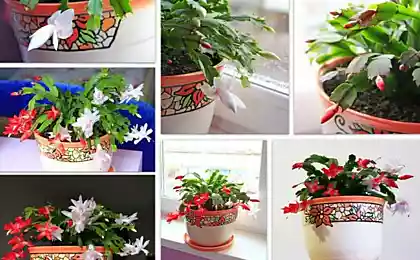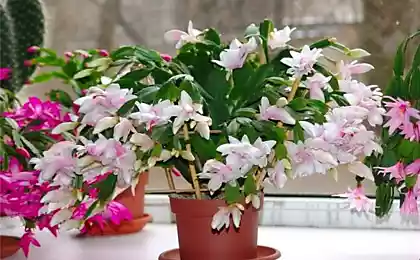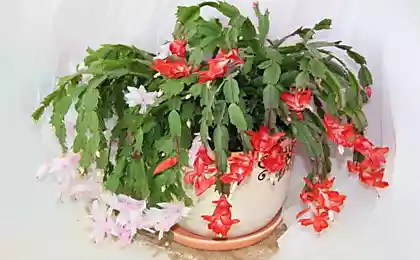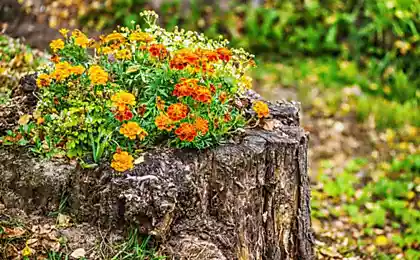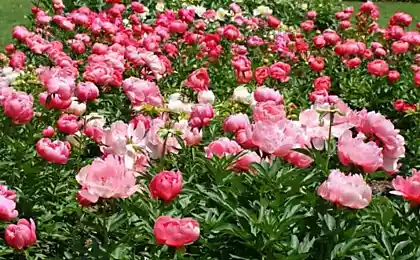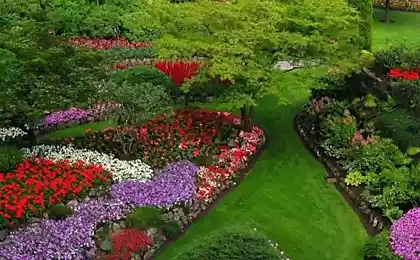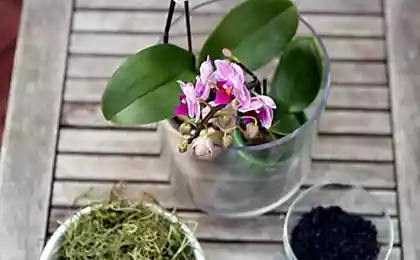486
Decembrist in Your home: features of care and the secrets of flowering
Hard to believe, but in nature there are cacti who love the water, afraid of the sun and do not have spines, they are called Decembrists, or schlumbergera, or Christmas cacti. They belong to the genus of South American epiphytic cacti growing in rainforests on tree branches.
Why they are called Decembrists? Yes, because they begin to bloom in the midst of a tropical summer in November-December and ends in late January. In our latitude the Christmas cacti were imported collector Allan Cunningham in 1816.

Flower Decembrist – features:
All plants have features. The main feature of the Decembrist is that it blooms when other flowers are resting. But he has other qualities that distinguish it from all other inhabitants of your windowsill.
First, the Decembrist uncomfortable on the southern and Western windowsills, because the intense light can cause the death of the ultimate segments of the shoots of the plant.
Second, in the summer, the Decembrist, like no other houseplant is in need of fresh air: a shaded area on the balcony, loggia, terrace.
Third, in the summer, the Decembrist likes to take a shower, but if this is not possible, then at least spray it from time to time.
Fourth, with good care survivor Decembrist can congratulate you with its bouquet of New year about 15 to 20 years.
Fifth, the flower of the Decembrist is time for those capricious plants which were not to be disturbed at the time of budding to move from place to place and even rotate the pot with the plant.
Sixth, the Decembrist can be grown as a normal plant, and can be, as a basket.
How to care for the Decembrists.
Agricultural zigokaktus Decembrist opposite farming practices actually cacti, their demands largely coincide with the growing conditions of conventional, leafy houseplants. If the cactus, you can forget to water it and it will not really suffer, the Decembrist require regular watering to defend the cool water and high humidity, which is achieved by regular spraying or by placing the pot with the Decembrist on a tray of wet pebbles.
Cacti can stand the sun, and the Decembrist suffers from direct sunlight and require shading. With regard to air temperature, the Decembrist in this matter he is not capricious. Since March, the Decembrist needs a monthly feeding of complex fertilizer for flowers, but the dose should be taken in two times less than suggested by the manufacturers. In the summer when the intensive growth of stems, fertilize the plant needs twice a month and feeding to stop. Can not hurt the plant and preventive treatment with fungicides.

How to cut the Decembrist.
Pruning of the Decembrist produce in June, and the excess part of the escape is not cut off, and Unscrew by hand, giving the plant a beautiful shape, shortening the shoots growing properly. Thus formed the plants have an attractive appearance and abundant bloom.
How to transplant a Decembrist.
Transplantation of the Decembrist produced after flowering at the end of February. Young plants are transplanted each year, adults – every 4-5 years. Pot plants choose low and wide as the root system of the Decembrist surface. The drainage layer should fill the pot one-third. As for soil, store-bought soil for cacti, but you can make the soil and your own: mix one part loam, and sand and two parts leaf soil, to disinfect, add the crushed coal, and for better permeability – brick chips or stone. The soil for the Decembrist to be acidic.
Reproduction of the Decembrists.
The answer to the question "how to propagate the Decembrist?" is very simple: vegetatively, by grafting. From escaping Unscrew 2-3 extreme "link", dried them for several days, then planted in moist soil and cover with a glass jar or plastic bottle to create a greenhouse effect. The container is placed in shade and ventilate regularly. The optimum temperature for rooting cuttings Decembrist 15-20ºC. Often propagated rodstvennik at home immediately after trimming as a result of the formation of the Bush remains ready material for grafting.
Pests and diseases of the Decembrist
Enemies of the Decembrists.
Annoy the Decembrist fungal diseases and insects. Fusarium, pithium and late blight, fungal diseases, pathogens which penetrate into the plant from contaminated soil, and the first to suffer from them the root collar of the plant. As a result, the flower becomes pale, gray, loses segments and wither in wet soil. Fusarium is treated with fungicides, and vitium and late blight – drugs "Maxim", "Topaz", "Vitaros".
If the plant is covered with a rusty patina, it is likely that it struck the spider mites are small insects point brown, yellow or reddish color that appear on the plant in the conditions of insufficient humidity. To get rid of the tick will help the preparations of the "Actellic", "Fitoverm" or "Neuron". Suddenly appeared between shoots whitish lumps, like cotton wool – some traces of the mealy bug, which can neutralize with the help of "Actory".
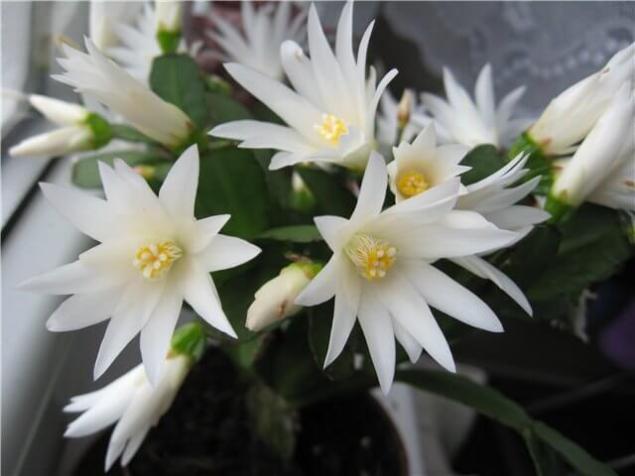
Why Decembrist wither.
Decembrist wither, as we have seen, if it is ill Phytophthora or fitima. Another reason for the dullness of the leaves may be a disease of the roots. If the plant has lost its stability, and its trunk swinging, it is quite possible that the roots of the plants died from hypothermia by watering with cold water in a cool room or, conversely, from the fact that the pot was hot in the sun. Could burn the roots of the Decembrist and too strong a concentration of fertilizer. In this case, the plant should be immediately transplanted to another substrate, because the old impregnated with concentrated fertilizer, which continues the destruction of the roots.
Why not bloom Decembrist.
The Decembrist must feel when it is time to bloom. For this he needs to provide full rest period: late September to late November, reduce watering and stop fertilizing plants by placing it in an unheated room. Now learn how to make the Decembrist bloom: bring a flower in a bright warm place and start to water, thereby helping the Decembrist Wake up. Turn the plant around the axis to achieve uniform illumination of all sides of the flower. As soon as you begin to form buds, ensure that the substrate in the pot doesn't dry out and that none of my family never moved and did not turn your flower, otherwise the plant may panic and lose the buds. If you follow these rules, your Decembrist necessarily blossom.
Why Decembrist fall.
Sometimes, seemingly for no reason, falling leaves the Decembrist. But just so nothing happens. Try to understand. It is known that the cause of "leaf" can be spider mites, and you already know how to get rid of it. If the pest you are detected, then a probable cause can be lack of nutrients (irregular feeding, depleted substrate).
Try it once or twice to spray the Decembrist of fertilizer solution for epiphytic cacti or make them at the root, and you will see how quickly the plant will recover their strength. If does not help, change the soil. The reason for the dropping of the final segments may become too dry or moved a plant stress – extreme temperatures, change in the environment, a draft or receive a transplant in time.
Room Decembrist after flowering
When the Decembrist Bud, start slowly to reduce watering by placing your plant in a cool place where it will stay until the end of March, resting after flowering. At the end of March of the Decembrist starts the vegetative period, so transfer the flower in its normal place, gradually increase watering and start to fertilize the plant. published
P. S. And remember, only by changing their consumption — together we change the world! ©
Join us in Facebook , Vkontakte, Odnoklassniki
Source: vk.com/public65997559?w=wall-65997559_80674
Why they are called Decembrists? Yes, because they begin to bloom in the midst of a tropical summer in November-December and ends in late January. In our latitude the Christmas cacti were imported collector Allan Cunningham in 1816.

Flower Decembrist – features:
All plants have features. The main feature of the Decembrist is that it blooms when other flowers are resting. But he has other qualities that distinguish it from all other inhabitants of your windowsill.
First, the Decembrist uncomfortable on the southern and Western windowsills, because the intense light can cause the death of the ultimate segments of the shoots of the plant.
Second, in the summer, the Decembrist, like no other houseplant is in need of fresh air: a shaded area on the balcony, loggia, terrace.
Third, in the summer, the Decembrist likes to take a shower, but if this is not possible, then at least spray it from time to time.
Fourth, with good care survivor Decembrist can congratulate you with its bouquet of New year about 15 to 20 years.
Fifth, the flower of the Decembrist is time for those capricious plants which were not to be disturbed at the time of budding to move from place to place and even rotate the pot with the plant.
Sixth, the Decembrist can be grown as a normal plant, and can be, as a basket.
How to care for the Decembrists.
Agricultural zigokaktus Decembrist opposite farming practices actually cacti, their demands largely coincide with the growing conditions of conventional, leafy houseplants. If the cactus, you can forget to water it and it will not really suffer, the Decembrist require regular watering to defend the cool water and high humidity, which is achieved by regular spraying or by placing the pot with the Decembrist on a tray of wet pebbles.
Cacti can stand the sun, and the Decembrist suffers from direct sunlight and require shading. With regard to air temperature, the Decembrist in this matter he is not capricious. Since March, the Decembrist needs a monthly feeding of complex fertilizer for flowers, but the dose should be taken in two times less than suggested by the manufacturers. In the summer when the intensive growth of stems, fertilize the plant needs twice a month and feeding to stop. Can not hurt the plant and preventive treatment with fungicides.

How to cut the Decembrist.
Pruning of the Decembrist produce in June, and the excess part of the escape is not cut off, and Unscrew by hand, giving the plant a beautiful shape, shortening the shoots growing properly. Thus formed the plants have an attractive appearance and abundant bloom.
How to transplant a Decembrist.
Transplantation of the Decembrist produced after flowering at the end of February. Young plants are transplanted each year, adults – every 4-5 years. Pot plants choose low and wide as the root system of the Decembrist surface. The drainage layer should fill the pot one-third. As for soil, store-bought soil for cacti, but you can make the soil and your own: mix one part loam, and sand and two parts leaf soil, to disinfect, add the crushed coal, and for better permeability – brick chips or stone. The soil for the Decembrist to be acidic.
Reproduction of the Decembrists.
The answer to the question "how to propagate the Decembrist?" is very simple: vegetatively, by grafting. From escaping Unscrew 2-3 extreme "link", dried them for several days, then planted in moist soil and cover with a glass jar or plastic bottle to create a greenhouse effect. The container is placed in shade and ventilate regularly. The optimum temperature for rooting cuttings Decembrist 15-20ºC. Often propagated rodstvennik at home immediately after trimming as a result of the formation of the Bush remains ready material for grafting.
Pests and diseases of the Decembrist
Enemies of the Decembrists.
Annoy the Decembrist fungal diseases and insects. Fusarium, pithium and late blight, fungal diseases, pathogens which penetrate into the plant from contaminated soil, and the first to suffer from them the root collar of the plant. As a result, the flower becomes pale, gray, loses segments and wither in wet soil. Fusarium is treated with fungicides, and vitium and late blight – drugs "Maxim", "Topaz", "Vitaros".
If the plant is covered with a rusty patina, it is likely that it struck the spider mites are small insects point brown, yellow or reddish color that appear on the plant in the conditions of insufficient humidity. To get rid of the tick will help the preparations of the "Actellic", "Fitoverm" or "Neuron". Suddenly appeared between shoots whitish lumps, like cotton wool – some traces of the mealy bug, which can neutralize with the help of "Actory".

Why Decembrist wither.
Decembrist wither, as we have seen, if it is ill Phytophthora or fitima. Another reason for the dullness of the leaves may be a disease of the roots. If the plant has lost its stability, and its trunk swinging, it is quite possible that the roots of the plants died from hypothermia by watering with cold water in a cool room or, conversely, from the fact that the pot was hot in the sun. Could burn the roots of the Decembrist and too strong a concentration of fertilizer. In this case, the plant should be immediately transplanted to another substrate, because the old impregnated with concentrated fertilizer, which continues the destruction of the roots.
Why not bloom Decembrist.
The Decembrist must feel when it is time to bloom. For this he needs to provide full rest period: late September to late November, reduce watering and stop fertilizing plants by placing it in an unheated room. Now learn how to make the Decembrist bloom: bring a flower in a bright warm place and start to water, thereby helping the Decembrist Wake up. Turn the plant around the axis to achieve uniform illumination of all sides of the flower. As soon as you begin to form buds, ensure that the substrate in the pot doesn't dry out and that none of my family never moved and did not turn your flower, otherwise the plant may panic and lose the buds. If you follow these rules, your Decembrist necessarily blossom.
Why Decembrist fall.
Sometimes, seemingly for no reason, falling leaves the Decembrist. But just so nothing happens. Try to understand. It is known that the cause of "leaf" can be spider mites, and you already know how to get rid of it. If the pest you are detected, then a probable cause can be lack of nutrients (irregular feeding, depleted substrate).
Try it once or twice to spray the Decembrist of fertilizer solution for epiphytic cacti or make them at the root, and you will see how quickly the plant will recover their strength. If does not help, change the soil. The reason for the dropping of the final segments may become too dry or moved a plant stress – extreme temperatures, change in the environment, a draft or receive a transplant in time.
Room Decembrist after flowering
When the Decembrist Bud, start slowly to reduce watering by placing your plant in a cool place where it will stay until the end of March, resting after flowering. At the end of March of the Decembrist starts the vegetative period, so transfer the flower in its normal place, gradually increase watering and start to fertilize the plant. published
P. S. And remember, only by changing their consumption — together we change the world! ©
Join us in Facebook , Vkontakte, Odnoklassniki
Source: vk.com/public65997559?w=wall-65997559_80674


